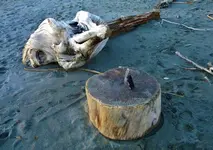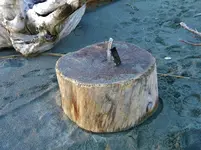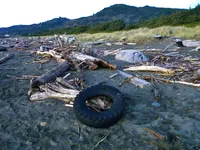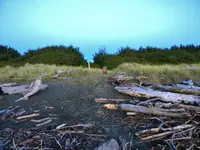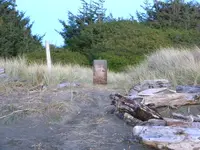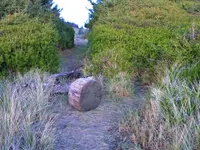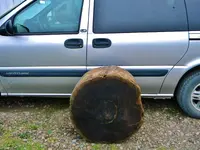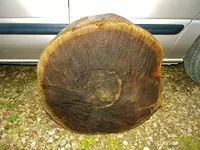Oh?? My apologies - I'll get some Selsan Blue in town today!

...That's a term I don't hear of much. As for your thoughts that it has spent a long time in the ocean, not necessarily. We live fairly close to the Red River, and it floods every -- single -- year!! One year when it flooded especially bad, we went for a drive that direction once the roads were open for local traffic only. The bridge going into ND was still closed, as crews always have to check the bridge for structural integrity. Anyway, we were driving through what looked like a driftwood battlefield!! County crews had gotten most of the debris off onto the side of the road, but there were still some pieces that I moved, just to keep anything from snagging on the underside. We brought back a healthy load of driftwood. What I learned from that experience was the truly awesome power of a flooded river and what it will do to wood. The vast majority of wood was green - meaning, it was alive and growing before the flood event. However, it looked as though it had been long-dead and weathered. How was this possible? Well, even though this is pretty much flat land, the river was swollen out that year about 15-20 miles wide, where it's normally only 70 yards or so. Water was going through dense forests as well as open farm fields. This is a windy area and one open field even had white caps! Driving through there reminded me a lot of driving through the Lake Pontchartrain Causeway in Louisiana, except that this water was mostly no more than 2' to 3' deep. All you could see in any direction was water - for MILES!! Only a little hint of greenery now and then where a tree line would be popping out. It was windy, but not nearly as bad as this area is known for. We stopped and chatted with a couple of the crew workers, who were also a great help in learning about these massive flood events.
In any case, the majority of really cool and interesting driftwood that we brought home was green. The wife thought it was just heavy from being in the water. However, I scraped a little bit on a few of the pieces and showed her the green and yellow colors - the colors of the wood when it's alive and fresh. She was amazed...as I must admit, so was I. Most of these pieces looked as though they had been dead for months; maybe years. Some were so heavy that I struggled to load them, and others she wanted I simply had to leave behind.
I forget how far it is from Hallock to the Red River, but is several miles. Most of that way was flooded. Driving that road, the main road had just gotten above the water again (some areas still had water over the road). On the side roads, you could see cars parked in the middle of nowhere with nobody around, as the only way for these people to get in and out of their homes was by boat. The wife has also told me how she grew up the same way, having to move out of the house each Spring as floodwaters would overtake everything and they'd always come home to having to clean the house, which would always have several feet of water in it. She said it was simply normal for them, and she never knew back then that this was not a normal life.

Anyway, the point of all this is to say that it's extremely difficult to look at a piece of wood that has been in active water, and know how long it has been there or how long it has been dead. Yes, your log does look like it was dead for quite some time and probably seasoned, even if naturally. But is a really cool piece, and my wife would have had me getting it home as well!!

Btw, we (mostly she) ended up making a driftwood fence to go along part of our driveway. It lasted a few years, but has since been torn down, as wood doesn't tend to last long in this area.
....Was also very active in woodworking for 26 years; everything from felling the trees to milling the wood to drying the lumber to finished product. So a Dendrologist, no....just knowledge from personal experiences.

